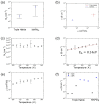Quantifying and Reducing Ion Migration in Metal Halide Perovskites through Control of Mobile Ions
- PMID: 37446688
- PMCID: PMC10343672
- DOI: 10.3390/molecules28135026
Quantifying and Reducing Ion Migration in Metal Halide Perovskites through Control of Mobile Ions
Abstract
The presence of intrinsic ion migration in metal halide perovskites (MHPs) is one of the main reasons that perovskite solar cells (PSCs) are not stable under operation. In this work, we quantify the ion migration of PSCs and MHP thin films in terms of mobile ion concentration (No) and ionic mobility (µ) and demonstrate that No has a larger impact on device stability. We study the effect of small alkali metal A-site cation additives (e.g., Na+, K+, and Rb+) on ion migration. We show that the influence of moisture and cation additive on No is less significant than the choice of top electrode in PSCs. We also show that No in PSCs remains constant with an increase in temperature but μ increases with temperature because the activation energy is lower than that of ion formation. This work gives design principles regarding the importance of passivation and the effects of operational conditions on ion migration.
Keywords: activation energy; defects; degradation; impedance spectroscopy; ionic mobility; mobile ion concentration; perovskite solar cells; stability; transient current; vacancies.
Conflict of interest statement
The authors declare no conflict of interest.
Figures




Similar articles
-
BiOBr Surface-Functionalized Halide Double-Perovskite Films for Slow Ion Migration and Improved Stability.ACS Appl Mater Interfaces. 2023 Apr 12;15(14):18473-18481. doi: 10.1021/acsami.3c00369. Epub 2023 Mar 28. ACS Appl Mater Interfaces. 2023. PMID: 36976570
-
Role of Decomposition Product Ions in Hysteretic Behavior of Metal Halide Perovskite.ACS Nano. 2021 May 25;15(5):9017-9026. doi: 10.1021/acsnano.1c02097. Epub 2021 May 6. ACS Nano. 2021. PMID: 33955732
-
Reduced Barrier for Ion Migration in Mixed-Halide Perovskites.ACS Appl Energy Mater. 2021 Dec 27;4(12):13431-13437. doi: 10.1021/acsaem.1c03095. Epub 2021 Dec 9. ACS Appl Energy Mater. 2021. PMID: 34977472 Free PMC article.
-
Mixed or Segregated: Toward Efficient and Stable Mixed Halide Perovskite-Based Devices.ACS Omega. 2021 Sep 8;6(38):24304-24315. doi: 10.1021/acsomega.1c03714. eCollection 2021 Sep 28. ACS Omega. 2021. PMID: 34604614 Free PMC article. Review.
-
Stabilizing Organic-Inorganic Lead Halide Perovskite Solar Cells With Efficiency Beyond 20.Front Chem. 2020 Jul 28;8:592. doi: 10.3389/fchem.2020.00592. eCollection 2020. Front Chem. 2020. PMID: 32850630 Free PMC article. Review.
Cited by
-
Mechanical and Ionic Characterization for Organic Semiconductor-Incorporated Perovskites for Stable 2D/3D Heterostructure Perovskite Solar Cells.Small. 2024 Dec;20(51):e2406928. doi: 10.1002/smll.202406928. Epub 2024 Oct 7. Small. 2024. PMID: 39375987 Free PMC article.
-
Pressure Engineering to Enable Improved Stability and Performance of Metal Halide Perovskite Photovoltaics.Molecules. 2025 Mar 13;30(6):1292. doi: 10.3390/molecules30061292. Molecules. 2025. PMID: 40142067 Free PMC article.
References
-
- Zhang W., Eperon G.E., Snaith H.J. Metal Halide Perovskites for Energy Applications. Nat. Energy. 2016;1:16048. doi: 10.1038/nenergy.2016.48. - DOI
-
- Song Z., McElvany C.L., Phillips A.B., Celik I., Krantz P.W., Watthage S.C., Liyanage G.K., Apul D., Heben M.J. A Technoeconomic Analysis of Perovskite Solar Module Manufacturing with Low-Cost Materials and Techniques. Energy Environ. Sci. 2017;10:1297–1305. doi: 10.1039/C7EE00757D. - DOI
MeSH terms
Substances
LinkOut - more resources
Full Text Sources
Research Materials

